How to find water for a well - different paths to the same
Just say, to find water under any part in the middle lane, not burdened with rocks and natural anomalies, is not difficult. As science says, there is necessarily an aquifer below. It is only necessary to determine the depth of their occurrence and power.
Of course, you can not lead, and there is no water in your area. But you investigated this situation ahead of time, still acquiring a plot. Thus, we assume that there is water. Now the main thing is to determine the search order.
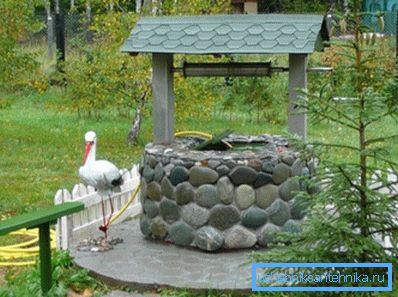
A bit of science, a little intuition, and, in general - art

To begin with, study what is called a materiel - the area that you will have to deal with (find out here how the lid for the well is done with your own hands).
There are four types of water layers:
- 1 - topline - the topmost and most unreliable layer at a depth of 4 meters; You can reach it with improvised means, but the water is often too dirty, since the layer is filled with normal precipitation, in the summer this layer can dry out almost completely;
- 2 - non-pressure groundwater - here the depth is already greater, up to 10 meters, and everything is much cleaner; these waters often feed wells;
- 3 - the so-called intermediate or water between the layers - there is also no pressure from below, but the depth can already reach 10 meters; often this layer uses clay from above and below as waterproof; from the top, water often penetrates the permeable layer;
- 4 - groundwater just thrown up - artesian; the depth of these is very different in different regions - in the Kuban, it can be up to 40 meters, and in the Moscow region, and all 250; Artesian water is considered the cleanest, although sometimes there are impurities.
Helpful advice! The first two layers are very similar to each other, so they are often called ground. The main water-resistant layers for the first three are sands, therefore they are often also called sandy. The sand does not withstand the water pressure from below, therefore limestone is the abutment for artesian water, hence another term - “limestone water”.
There are, respectively, two more terms related to drilling - “drilling in the sand” and “drilling in the limestone”. We advise you to accurately grasp this terminology.
If you describe the picture in more detail, it looks much more complicated:
- 1 - topline;
- 2 - interstitial non-pressure water;
- 3 - groundwater;
- 4 - interlayer pressure head, artesian, water;
- 5 - a nearby reservoir - note that the level of this reservoir may be below the level of the artesian layer, in turn, it is very important to ensure proper pressure, to ensure the well exit above this level - everything is quite simple, the same law of communicating vessels open almost 400 years ago, in the 17th century, by Italian Torricelli.
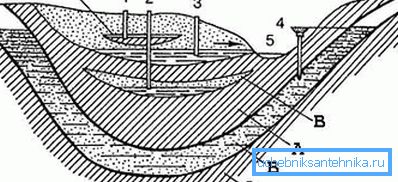
The water is surrounded:
- A - clay, and,
- B - sand.
In general, when you have to drill, be prepared for the following layers:
- A - at the top, which is not a surprise, you will start with half a meter of slightly decomposed peat;
- B - then 2 meters of slightly degraded earthy sandy loam will go;
- C - followed, also 2 meters of clay;
- D - here comes the turn of the sands to a depth of 2 meters, although, as a rule, it is less;
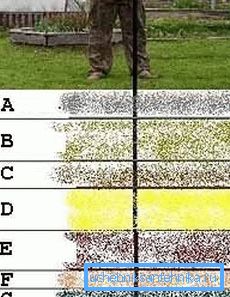
- E - as a forerunner of water - the upper waterproof layer of clay, up to 2.5 meters;
- F - very thin plavun 5 cm thick;
- G - predzhilnik, which can and not notice, 20 cm;
- H is the water layer itself, which, unfortunately, can be only 10-20 cm thick.
We are looking for, knowing what awaits us below
The search for water is carried out according to the well-known scheme - from simple to complex.
Where do we start
The first steps in the search are very simple:
- Be sure to go through the sites of all your neighbors and find out the situation from them; Make a diagram of the location of the water layers of the neighbors, for which choose areas located on all sides; if the neighboring water has:
- rather long time wells or wells in use;
- the water is clean enough to not even use filters,
- then you will have water and you can start test drilling;
- then we go out to the area and explore the nearby reservoirs; if the reservoirs are sufficiently filled and do not dry up in summer, then most likely you will have water in the area.
Shaman actions
If the first visual actions cannot give encouraging answers to the question if there is hope for water below, try the old ways that have proven their truth for more than one hundred years:
- take two hollows, one year old, preferably hazel, connect them at one end, and dissolve the other two ends (a);
- confidently take this design in the palm of your hand, but do not squeeze, let it freely look horizontally forward;
- head forward, holding the vine in front of you;
- where it begins to clearly descend, there it is very likely that you can find water;
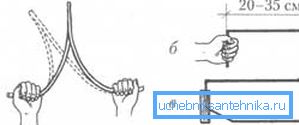
- if you didn’t have a vine under your hands, make a device of one or even two electrodes ("b" and "c");
- electrodes must be able to rotate freely at the slightest impact;
- walk around the site, where the rods will begin to rotate, and the water will lie down;
- but keep in mind that the framework may be misleading; they respond to:
- and it can be very weak, and, on
- underground communications, and this is a completely different song, as they say in Odessa.
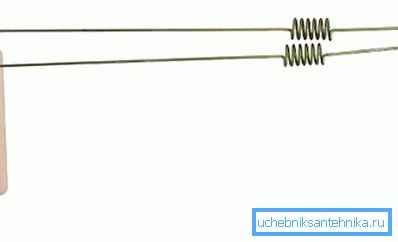
What will help nature
There are signs of the presence of water in the ground, which nature itself gives us:
- First of all, trees can help:
- Oak, alder, willow, nettle, fern grow well up in places where groundwater is close to the surface;
- if birch, alder and a weeping willow were leaning together to the left or to the right, it means that there is water under them, and to the side where the slope points;
- if an oak tree stands alone, not only lived under it, but not even one.
- according to the scheme below it can be seen that the most promising in thickness layers are indicated by bird cherry, oak, juniper, hazel, beech - here you can expect a layer up to 7-8 meters thick;
- All the berries promise water and not deep, but it will be a bit - only 1-2 meters thick.
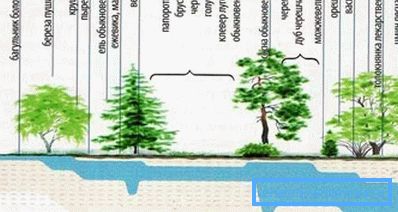
- secondly, as always helps the behavior of animals; water can be expected where:
- thirsty animals begin to dig for water;
- the cat will settle down to rest, and the dog of this in the same place will be wary;
- the chicken will not carry the eggs, and the goose, on the contrary, will bring something to her;
- midges and mosquitoes rummage at sunset;
- Thirdly, dig a well where:
- after sunset the fog spreads;
- there are springs, and the earth, when cold weather comes in winter, freezes early and quickly;
- a layer of fairly hard clay;
- the earth is damp and at a depth of one meter.
Helpful advice! Strictly speaking, there is no one “magic” sign of the presence of water under the ground. Therefore, we advise you to collect a whole bunch of signs into your collection and analyze them all carefully. Only such an approach will tell you where to drill, and even then a trial one.
As always on guard and chemistry
In a pinch, you can try another trick of the search - using a dry, supersaturated acid solution - silica gel, which has a very strong ability to absorb water from the environment.
In this way
- In places of search, bury for a day in different places moisture-permeable bags with silica gel;
- if after 24 hours the bag is significantly heavier due to the wetting of the substance, there is water.

The method is quite effective, if not a few but:
- first, the substance reacts to gasoline, and to ether and to all other similar substances;
- secondly, silica gel leaves much to be desired from the point of view of fire and explosion safety;
- thirdly, this preparation contains up to 70% of silicon dioxide and it is not recommended to work with it without respiratory protection.
findings
The search for water layers in your area may seem like a game, if not for one circumstance - the price of victory in this game is nothing less than your welfare in the area. Therefore, treat the game as a fun, but very serious, in which there is no one way to achieve success (see also the article Well houses to protect drinking water sources).
Be sure to watch the additional video in this article, it will not let you just walk around the site with the “chopsticks”, but set up a more serious mood.